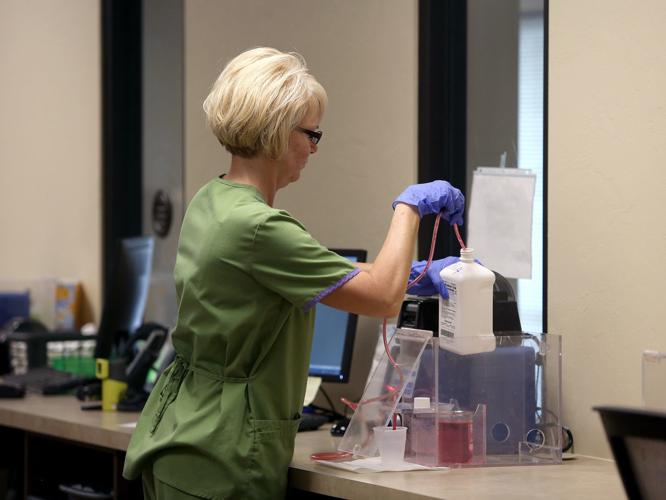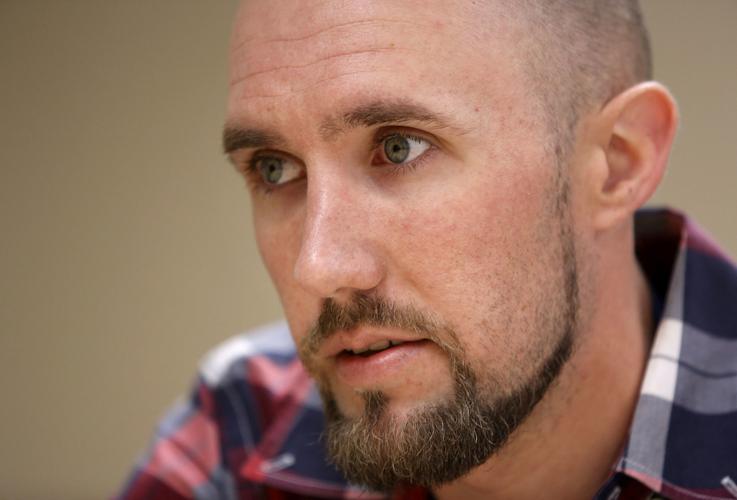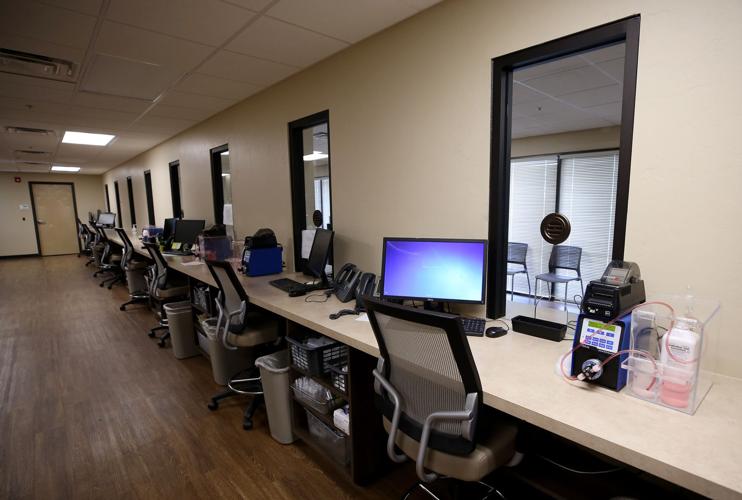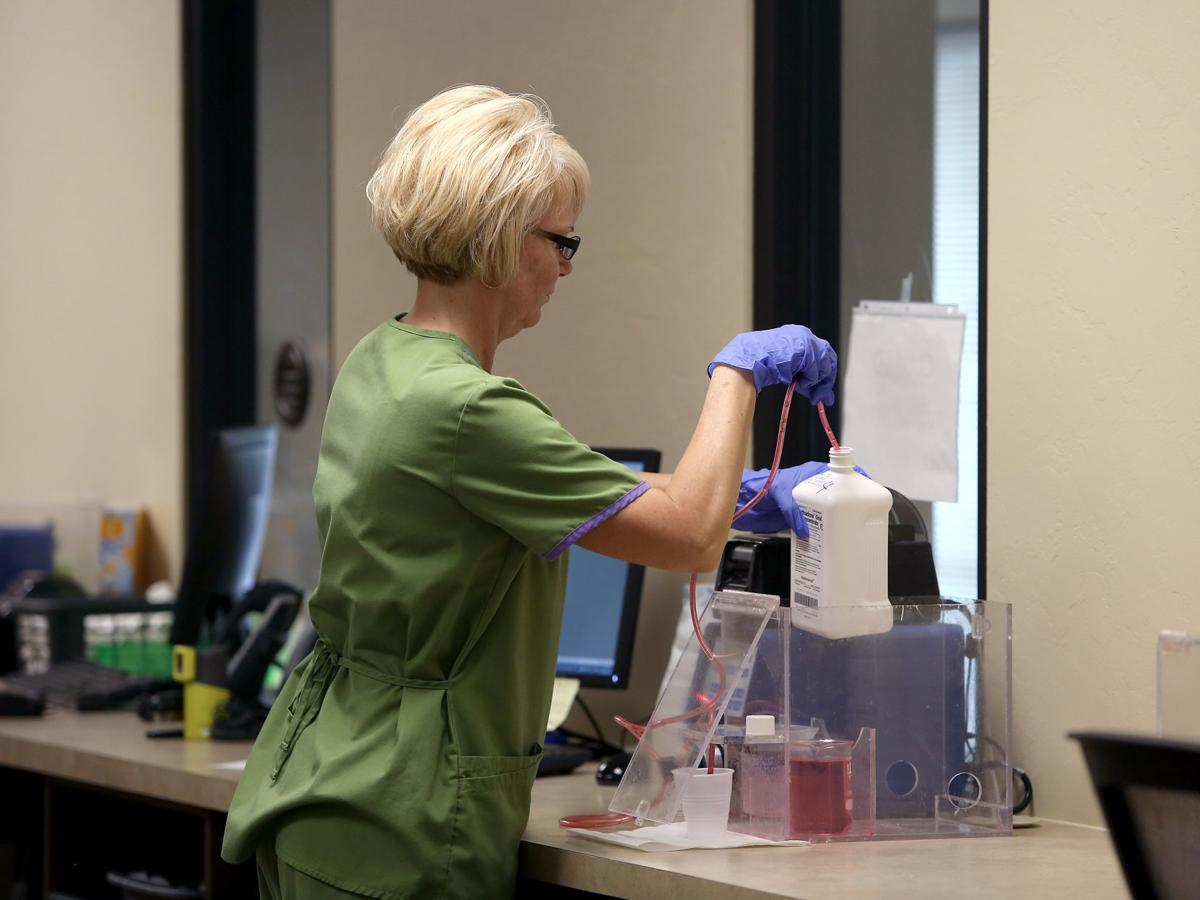Tucson’s first 24/7 methadone clinic is an emblem of the community’s opioid problem — the 21,000-square-foot facility costs $3.3 million annually and is seeing an increasing number of clients.
Operated by CODAC Health, Recovery and Wellness, the 380 E. Fort Lowell Road clinic does not only offer methadone. Its official name is a MAT, which stands for medication-assisted treatment.
Methadone, an opioid replacement, remains the most commonly used drug for clients at the clinic who are trying to stop using opioids like heroin and pain relievers such as OxyContin (oxycodone), codeine and morphine.
In addition to methadone, the CODAC MAT clinic offers Suboxone (buprenorphine and naltrexone) and Vivitrol (extended-release naltrexone) to help people quit their addictions. The medications help physically, so a person is more able to take part in their treatment.
While MAT clinics have been criticized for “replacing one addiction with another” and for giving drug companies another financial windfall, the science says the use of medications available at MAT clinics is a proven treatment approach for people struggling with harmful opioid addictions.
Peer-reviewed medical studies have shown MAT decreases opioid use, opioid-related overdose deaths, criminal activity and infectious-disease transmission.
CODAC officials say they’ve encountered stigma in the Tucson community, where people aren’t allowed to live in residential programs if they are using MAT services. What they try to explain is that the goal is always abstinence from opioids, but MAT helps people get there.
Giving up opioids all at once makes people sick, said Dan Barden, who is CODAC’s vice president for clinical services. The withdrawals can be long and horrible, he said. In pregnant women, that illness can compromise the baby.
Methadone and Suboxone are long-acting opioids that work by reducing cravings and preventing withdrawal. Vivitrol works by blocking opioid receptors from activating so that even if someone uses heroin, they won’t be able to get high.
“Opioid withdrawal is arguably one of the worst states of being a human can go through,” said Dr. Leonard Ditmanson, chief medical officer of America’s Rehab Campuses, which has a 206-bed residential treatment program in Tucson.
“You might want to die. It’s just that bad. The fear of withdrawal is so motivating that just the fear is enough to keep people using.”
Ditmanson helped set up a MAT clinic for pregnant women at the Pima County jail and has been working in the local substance-misuse-treatment field for nearly 20 years.
MAT normalizes people’s lives so they can function, Ditmanson said. He noted that even the Hazelden Betty Ford treatment and addiction centers, which were founded on a strict philosophy of abstinence, have started using medication-assisted treatment for opioid addictions.
“There are a lot of behavioral components in addiction and that’s what gets people into trouble,” Ditmanson said. “The substance of MAT is opioid replacement. You are monitored, it’s controlled.”

The dosing area inside the CODAC Health, Recovery and Wellness’ 24-hour methadone clinic on Fort Lowell Road.
“Liquid handcuffs”
The new CODAC clinic space includes an off-duty police officer, a high-security locked vault, psychiatrists, nurses and recovery managers who help clients with expected relapses. The need for MAT gets people in the door, but once they are there the clinic provides a “whole patient” approach with services like behavioral therapies, medical care and job assistance.
On a recent Tuesday afternoon, the waiting room was bustling as men and women of all ages lined up to get their doses and enroll in related services, such as counseling and hepatitis C testing.
Some people stay on medication-assisted treatment for years. Others don’t stick with it, as the commitment is significant — methadone has earned the nickname “liquid handcuffs” because it typically requires showing up at a clinic every day to get the prescribed dose of pink liquid.
The average age of clients at the CODAC facility is 43 for males, and 41 for females. Most of the clients are covered by Medicaid, a government insurance program for low-income people. The clinic accepts commercial insurance, too.
Opioid replacement drugs like methadone and Suboxone have less potential for abuse largely because of the duration they have in the brain, Ditmanson said.
Within seconds of injecting heroin, the person using it begins to nod their head and “slips into a purple haze,” he said. Not so with the opioid replacements methadone and Suboxone.
“Heroin and most of the drugs of abuse have very short half-lives, which means you have to keep going back to the well because you keep going into withdrawal, you have to keep using, the body gets tolerant and then you have to use more,” Ditmanson said.
“If you take a dose of methadone, say 100 milligrams, it’s going to last you until tomorrow when you take another dose. ... You are simultaneously fulfilling and depressing the craving and the need to use.”
“We can’t just stop”
CODAC has been offering MAT since the 1970s and most recently operated out of less than 7,000 square feet on First Avenue, about a half-mile away from the new facility. The clinic used to be solely about treating a consistent local population of people addicted to heroin.
But as misuse of prescription painkillers increased, in recent years the need has eclipsed space. The number of individuals using CODAC’s MAT clinic is 151 percent higher than it was 10 years ago.
The new clinic location, which CODAC is leasing from Rio West, is seeing more than 800 users per month right now and numbers have been steadily rising since the beginning of the year, when hours were extended to 24/7.
Most of the increase has been in the last four years, when the numbers doubled, the data shows, and the clinic’s size allows room for expansion.

Brendan Bond, 28, takes Suboxone to curb his cravings for heroin and is a peer-support specialist with CODAC.
“I used to see it as government drugs. A lot of people look down on it, but they don’t understand we need a transition, we can’t just stop,” said 28-year-old Brendan Bond, who uses the MAT clinic to get regular doses of Suboxone and works as a peer-support specialist at a transitional-living house operated by CODAC.
Bond, who was born and raised in Tucson, started Suboxone in 2014 when he was struggling with an addiction to heroin that developed after he got hooked on painkillers. He’d give up the heroin and then relapse — “it would itch me,” he said.
Bond had been through various rehab programs; none had worked.
The addiction pattern was frustrating and seemingly endless. He was risking prison, since he was on probation. He was also risking an overdose, which he’d witnessed happen to friends.
Drug overdose deaths in Pima County have increased by 27 percent since 2010 (compared with population growth of about 2 percent) and 66 percent of the overdose deaths last year involved opioids, county data show. Those who died ranged from four teenagers to three people in their 80s.
“At first you are chasing a high, but eventually you don’t get anything from it. You are just trying to stay well,” Bond said. “With the Suboxone, you don’t worry about the withdrawals. You feel well enough to get a job and do other stuff.”
Bond has been tapering his doses of Suboxone and eventually wants to get off it altogether, but it has taken a lot of work. Staying away from heroin also requires staying away from old friends and finding a new structure for one’s life, he said.
“The Suboxone gets your physical being right, so that you can get your mental state right,” he said.
Reuven Shorr, 34, has been getting methadone doses at COPE Community Services in Tucson for four-and-a half years. He began two months after his brother died of an overdose and still goes to COPE’s clinic in person six days per week. He gets his Sunday dose in a take-home bottle.
Before he started methadone, Shorr had heard only negatives, including that it was more addictive than painkillers.
The biggest downside is that it’s hard to travel, he said. A trip to Virginia a couple of years ago required extensive pre-planning in order to get his doses.
Still, going on methadone is a decision he doesn’t regret.
“The best thing it did for me is that since I started I haven’t had the urge. It eliminated the cravings,” said Shorr, who recently earned his recovery support specialist certification.
“I’d still say it’s as addictive, if not more, than opioids. It’s just different in my mind.
“It’s the most important thing in my day. It makes it so I can function.”
His plan is to eventually get off of methadone altogether, and he’s been working on that, gradually tapering his dosage.
“When I was using every day, that was my whole day. I’d try to find money to get pills. With methadone, that’s been eliminated.”

There are staff meetings twice a week at the CODAC Health, Recovery & Wellness’ 24-hour methadone clinic on at 380 E. Fort Lowell Road. March 27, 2018
Why 24/7
While most of the CODAC clients are using methadone, each client is assessed at intake to figure out the best treatment for their needs.
The reason that 24/7 hours are helpful is that it allows people to access help at the moment they need it. And if someone still has heroin or another opioid in their system, the facility can let them stay until they can begin treatment with methadone or another drug.
“The biggest advantage is having the opportunity to start folks on medications within that 24-hour period when they first show up,” Barden said. “So somewhere in that first day 24-hour period, they are getting dosed.”
Barden said CODAC officials have already noticed that more people are following through, by coming back for doses.
An initial $1 million in federal grant money helped the facility go 24/7 — the money was part of $24 million awarded to Arizona to combat opioid-use disorder and opioid-related deaths. Improving access to comprehensive medication-assisted treatment programs was a key initiative of the grant.
Ditmanson recalls that when he was in charge of the COPE MAT clinic in 2005, most MAT clinics had a capacity of 250 to 350 patients. Now capacities are going up to the 1,000-patient range, he said.
The U.S. Food and Drug Administration recently announced plans to broaden access to MAT clinics, and expansion is already happening locally.
A new MAT clinic operated by Community Partners Integrated Health Care is expected to open on Tucson’s south side, and COPE Community Services has begun an adolescent MAT clinic that treats teens as young as 16. COPE has one adult MAT clinic and is working on opening another.
The need could continue with more awareness about MAT. The federal Substance Abuse and Mental Health Services Administration says nearly 80 percent of individuals with an opioid use disorder do not receive treatment.








